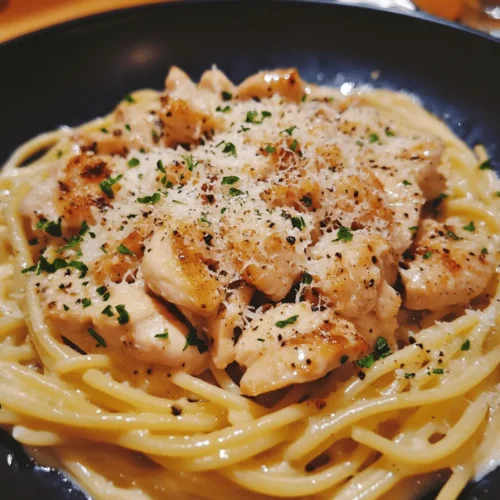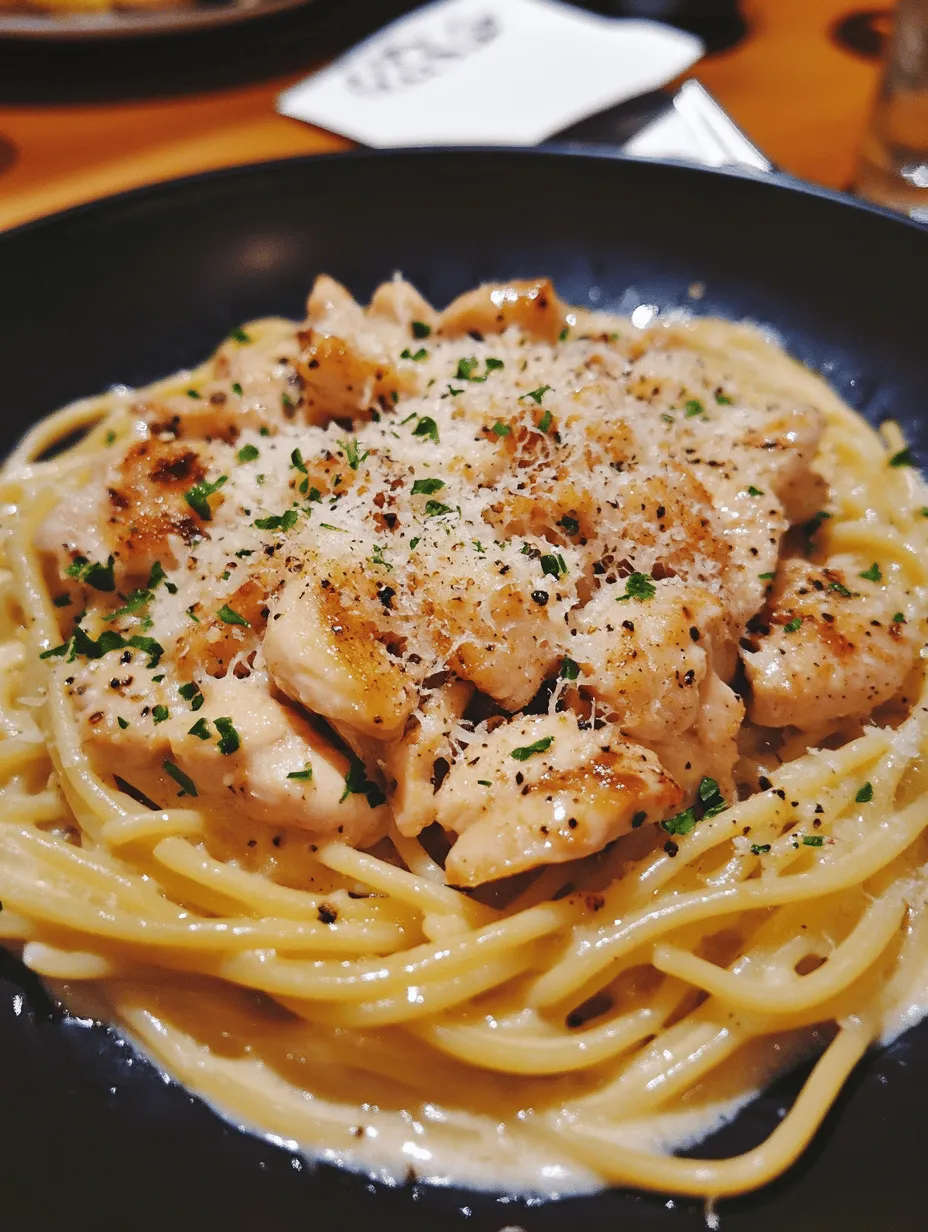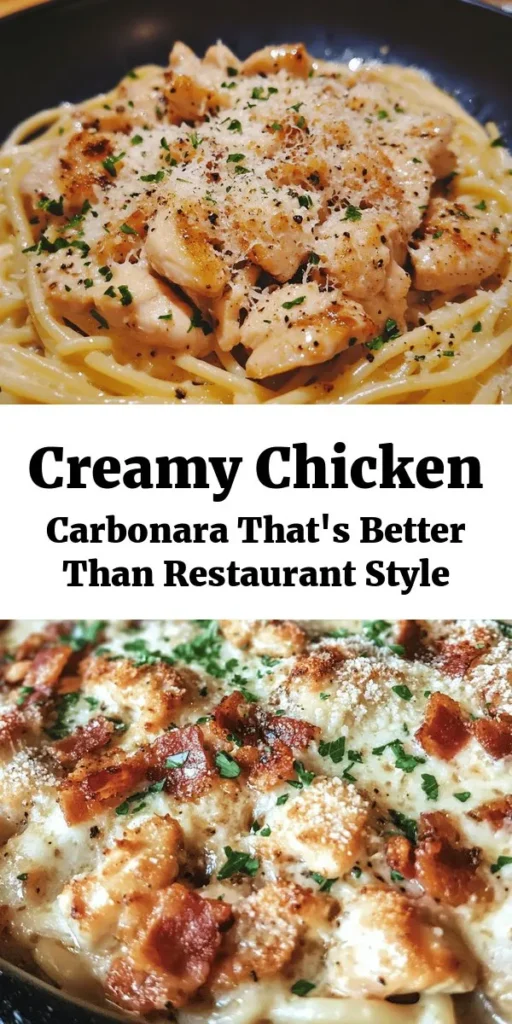Introduction
Chicken Carbonara is a delightful twist on a classic Italian dish that has won the hearts of many food lovers around the world. Traditionally, Carbonara is a Roman pasta dish made with eggs, cheese, cured pork, and black pepper, creating a creamy and rich sauce that perfectly coats the pasta. While the original recipe is undeniably delicious, incorporating chicken into the mix offers a heartier alternative that is perfect for weeknight dinners or special occasions.
The beauty of Chicken Carbonara lies not only in its flavor but also in its quick preparation time. In just about 30 minutes, you can whip up a satisfying meal that will impress family and friends alike. This dish is a true crowd-pleaser, combining comforting flavors with a touch of elegance that makes it suitable for any dining experience.
When it comes to achieving the best flavor in your Chicken Carbonara, the importance of using quality ingredients cannot be overstated. Fresh, high-quality products will elevate your dish, bringing out the authentic Italian flavors that make this meal so special. In this article, we will guide you through the origins of Carbonara, the essential ingredients you’ll need, and step-by-step instructions for preparing the best-ever Chicken Carbonara.
Understanding the Origins of Carbonara
The origins of Carbonara are often debated among culinary historians, but one prevailing theory suggests that the dish was created in the mid-20th century, particularly during World War II. American soldiers stationed in Italy were said to have combined their rations of eggs and bacon with local pasta, giving rise to what we now know as Carbonara.
Traditionally, Carbonara is made with spaghetti or rigatoni, paired with guanciale (cured pork cheek), eggs, Pecorino Romano cheese, and black pepper. These ingredients reflect the rustic simplicity of Italian cooking, where quality and freshness take precedence over extravagance. The richness of the dish comes primarily from the emulsification of eggs and cheese, which creates a silky sauce that clings to the pasta.
Over the years, various adaptations have emerged, with some recipes incorporating cream, vegetables, or different types of meats. However, purists maintain that the true essence of Carbonara lies in its simplicity and use of traditional ingredients. The significance of eggs and cheese in Italian cuisine cannot be understated, as they create a harmonious balance of flavor and texture that is both comforting and indulgent.
Essential Ingredients for Best-Ever Chicken Carbonara
To make the best-ever Chicken Carbonara, it’s essential to gather high-quality ingredients that will contribute to the dish’s rich flavor and creamy texture. Here’s a closer look at the main components:
Pasta: Choosing Between Spaghetti and Fettuccine
When it comes to pasta for Carbonara, spaghetti is the classic choice due to its long, thin shape, which allows the sauce to cling beautifully. However, fettuccine is also a fantastic option, particularly if you prefer a wider noodle that can hold onto the creamy sauce even better. Whichever you choose, ensure it is of good quality—fresh or dried pasta will both work, but fresh pasta will yield a more delicate texture.
Chicken: The Importance of Using Boneless, Skinless Breasts
For this Chicken Carbonara, boneless, skinless chicken breasts are the ideal choice. They are lean, tender, and cook quickly, making them perfect for a weeknight meal. Ensure that the chicken is fresh for the best flavor. If you want to add extra flavor, consider marinating the chicken briefly in olive oil, garlic, and herbs before cooking.
Pancetta vs. Bacon: Flavor Profiles and Cooking Differences
In traditional Carbonara, guanciale is used, but pancetta is a suitable alternative that is often more accessible. Pancetta is an Italian cured meat made from pork belly, offering a rich, savory flavor that enhances the dish. If you prefer a smokier taste, you can substitute pancetta with bacon. Keep in mind that the cooking times may vary slightly, as bacon tends to render more fat than pancetta.
Pecorino Romano Cheese: Why It’s the Best Choice
Pecorino Romano cheese is the quintessential cheese for Carbonara. This hard, salty cheese made from sheep’s milk adds a sharp, tangy flavor that beautifully complements the richness of the eggs and chicken. If Pecorino Romano is not available, you can use Parmigiano-Reggiano or a combination of both, but be aware that the flavor profile will change slightly.
Garlic: Enhancing Flavor with Aromatics
While traditional Carbonara does not typically include garlic, adding a clove or two can enhance the overall flavor of the dish. Sautéing garlic in olive oil before adding the chicken can infuse the meat with aromatic goodness, providing a subtle depth to the sauce.
Olive Oil: Its Role in Cooking and Flavor Development
Extra virgin olive oil is essential for cooking the chicken and pancetta. It adds a layer of flavor and helps achieve the perfect sear on the chicken. Olive oil is also a key ingredient in Italian cuisine, offering health benefits and a delicious taste that complements the other components of the dish.
Seasoning: The Importance of Salt and Pepper
Seasoning is crucial in any recipe, and Chicken Carbonara is no exception. A generous pinch of salt will help enhance the flavors of the dish, while freshly cracked black pepper adds warmth and a hint of heat. Remember to taste as you go to achieve the perfect balance.
Step-by-Step Instructions for Preparing Chicken Carbonara
Now that we’ve covered the essential ingredients, let’s dive into the step-by-step process of creating the best-ever Chicken Carbonara. Each step is designed to ensure that your dish turns out perfectly creamy and delicious.
Cooking the Pasta: Techniques for Achieving Perfect Al Dente
1. Boil Water: Fill a large pot with water and add a generous amount of salt. Bring the water to a rolling boil.
2. Add Pasta: Once the water is boiling, add your chosen pasta (spaghetti or fettuccine) and cook according to the package instructions until al dente. This typically takes about 8-10 minutes, depending on the type of pasta.
3. Reserve Pasta Water: Before draining the pasta, reserve about a cup of the pasta cooking water. This starchy water will be crucial for adjusting the sauce’s consistency later on.
4. Drain and Set Aside: Drain the pasta in a colander, shaking off excess water, and set it aside while you prepare the chicken and sauce.
Preparing the Chicken: Tips for Achieving Golden-Brown Texture
1. Season the Chicken: Pat the boneless, skinless chicken breasts dry with paper towels. Season both sides generously with salt and freshly cracked black pepper.
2. Heat the Olive Oil: In a large skillet or frying pan, heat a tablespoon of extra virgin olive oil over medium-high heat until shimmering.
3. Cook the Chicken: Add the chicken breasts to the skillet, making sure not to overcrowd the pan. Cook for about 6-7 minutes on each side, or until golden brown and cooked through. The internal temperature should reach 165°F (75°C).
4. Rest the Chicken: Once cooked, transfer the chicken to a cutting board and let it rest for a few minutes. This helps lock in the juices, ensuring tender meat.
5. Slice the Chicken: After resting, slice the chicken into bite-sized pieces, ready to be incorporated into the Carbonara.
Cooking the Pancetta: Achieving Optimal Crispiness
1. Cook the Pancetta: In the same skillet used for the chicken, add the diced pancetta (or bacon) over medium heat. Cook until it’s crispy and golden, about 5-7 minutes. Stir occasionally to ensure even cooking.
2. Drain Excess Fat: Once the pancetta is cooked, use a slotted spoon to remove it from the skillet and place it on a plate lined with paper towels to absorb excess fat, leaving the rendered fat in the skillet for flavoring the sauce.
Combining Ingredients: Techniques for Seamless Integration
1. Add Garlic: If using garlic, add minced garlic to the same skillet with the pancetta fat and sauté for about 30 seconds until fragrant. Be careful not to burn the garlic, as it can turn bitter.
2. Combine Pasta and Ingredients: Add the drained pasta to the skillet, tossing it in the rendered fat and garlic until well-coated.
3. Create the Sauce: In a separate bowl, whisk together the eggs and grated Pecorino Romano cheese until smooth. Pour this mixture over the hot pasta, quickly tossing everything together. The heat from the pasta will gently cook the eggs, creating a creamy sauce.
4. Adjust Consistency: If the sauce appears too thick, gradually add some of the reserved pasta water until you reach your desired creaminess. The sauce should cling beautifully to the pasta.
5. Fold in Chicken and Pancetta: Add the sliced chicken and crispy pancetta to the pasta, gently folding them into the mixture to combine all the flavors.
With these steps, you’ll be well on your way to creating an unforgettable Chicken Carbonara that embodies the essence of Italian cuisine while offering a satisfying, hearty twist. Stay tuned for more tips and tricks in the following sections of this article!

Mixing the sauce for Chicken Carbonara requires precision and attention to detail. The timing and temperature control are crucial to ensure that the eggs emulsify smoothly with the cheese, creating a creamy and luscious sauce. To achieve this, start by mixing the egg yolks and grated cheese in a bowl. As the pasta cooks, keep an eye on the timing. Once the pasta is al dente, reserve a cup of the pasta water before draining it. This water is essential for adjusting the sauce’s consistency later on.
After draining the pasta, let it cool slightly for a minute before adding it to the egg and cheese mixture. This step is critical. If the pasta is too hot when it meets the egg mixture, you risk scrambling the eggs. Instead, the residual heat from the pasta should gently cook the eggs, creating a velvety sauce. Stir quickly to combine the ingredients, and add reserved pasta water a little bit at a time until you achieve your desired creaminess.
Final seasoning is an important part of perfecting your Chicken Carbonara. After mixing the pasta with the sauce, taste it. This is your opportunity to adjust the seasoning. A pinch of salt, a dash of black pepper, or even a sprinkle of garlic powder can enhance the overall flavor. Remember, the cheeses you use can also contribute saltiness; therefore, it’s essential to taste before adding more salt.
Tips for Achieving the Creamiest Carbonara
To master the art of creamy Chicken Carbonara, understanding the science behind emulsifying the sauce is vital. The emulsification process occurs when fats from the cheese and the pasta water bind together with the egg yolks. This creates a silky texture that clings beautifully to the pasta. To achieve this, make sure to whisk the egg mixture vigorously while slowly incorporating the pasta. The key is to combine them while the pasta is still warm but not boiling hot.
Reserved pasta water plays a crucial role in creating the sauce. This starchy water helps bind the sauce to the pasta, making it creamier and preventing it from becoming too thick or clumpy. Always keep a cup of pasta water on hand, as you may need to adjust the consistency of your sauce.
Another technique to avoid scrambled eggs in your Chicken Carbonara is to mix the sauce off the heat. This prevents the eggs from cooking too fast. After you have combined the pasta with the egg and cheese mixture, return it to the stovetop only to keep it warm, not to cook it further. Stir continuously to ensure a smooth and creamy texture.
Serving Suggestions and Presentation
The ideal serving temperature for Chicken Carbonara is slightly warm, allowing the flavors to meld beautifully. For plating, twirl the pasta into nests for a visually appealing presentation. Use a pair of tongs to lift the pasta from the pot and create a spiral shape on the plate. This not only looks elegant but also allows guests to enjoy the dish from the first bite.
Garnishing options can elevate your Chicken Carbonara significantly. Fresh parsley adds a pop of color and a hint of freshness, while extra cheese brings an indulgent element. Consider using Pecorino Romano or Parmesan for an extra touch of flavor. A light sprinkling of cracked black pepper can also enhance the dish’s aroma and taste.
Pairing recommendations include a crisp white wine like Pinot Grigio or Chardonnay, which complements the richness of the carbonara without overpowering it. If you prefer a non-alcoholic option, a sparkling water with a twist of lemon can refresh the palate between bites. As for side dishes, a simple arugula salad drizzled with olive oil and lemon juice provides a nice contrast to the creamy pasta.
Nutritional Benefits of Chicken Carbonara
Understanding the nutritional content of Chicken Carbonara can help you appreciate this dish even more. Chicken breast is a lean protein source, which is essential for muscle repair and growth. It’s low in fat and high in protein, making it an excellent choice for a balanced diet.
The pasta provides carbohydrates, which are a key energy source for the body. Opting for whole grain or legume-based pasta can increase the fiber content, promoting digestive health. Additionally, the eggs in the carbonara contribute essential nutrients like vitamin D and B vitamins, which are crucial for various bodily functions.
While Chicken Carbonara is undeniably indulgent, balancing this dish with nutritious ingredients can create a well-rounded meal. Using fresh herbs, quality cheese, and lean chicken ensures that you can enjoy this classic recipe without compromising on health.
Common Mistakes to Avoid When Making Carbonara
To truly perfect your Chicken Carbonara, there are common mistakes to watch out for. Overcooking the pasta is one of the primary pitfalls. Pasta that is too soft will not hold the sauce well and can lead to a mushy texture. Always cook the pasta until it’s al dente, as it will continue to cook slightly when combined with the sauce.
Using the wrong cheese can also affect the flavor and creaminess of your dish. Stick with traditional Italian cheeses like Pecorino Romano or Parmigiano-Reggiano, as they provide the authentic taste and texture that make carbonara unique. Avoid using pre-shredded cheese, as it often contains anti-caking agents that can prevent proper melting.
Timing the sauce mixing is another critical factor in achieving the perfect carbonara. If you mix the egg mixture with the pasta while it’s still on high heat, you risk ending up with curdled eggs. Always remove the pan from the heat before adding the egg and cheese mixture, allowing the residual heat to gently cook the sauce.
Creative Variations on Chicken Carbonara
Once you’ve mastered the classic Chicken Carbonara, consider exploring creative variations to keep things exciting. Adding vegetables like peas, spinach, or mushrooms can introduce new textures and flavors while boosting the nutritional profile of your dish. For a heartier meal, try incorporating different proteins such as pancetta, shrimp, or even crispy bacon.
Global twists can also provide an interesting spin on this beloved dish. For instance, integrating flavors from Asian cuisine by adding soy sauce and sesame oil can create a unique fusion experience. Alternatively, a hint of smoked paprika can give your carbonara a Spanish flair, adding depth and warmth.
If you’re looking for a healthier option, vegan adaptations are increasingly popular. Substitute traditional pasta with zucchini noodles or whole grain pasta, and replace the chicken with marinated tofu or chickpeas. For the sauce, blended cashews or silken tofu can create a creamy texture without dairy, making it a delicious plant-based alternative.
Conclusion
In conclusion, making Chicken Carbonara is not just about following a recipe—it’s about embracing the art of cooking and the joy of sharing delicious food with loved ones. The delightful creaminess, the umami of the cheese, and the tender chicken create a dish that is both comforting and satisfying. Don’t hesitate to experiment with this recipe; whether it’s through creative variations, ingredient swaps, or unique garnishes, the possibilities are endless.
Remember, cooking is a journey, and each meal is an opportunity to explore flavors and techniques. As you gather around the table with family and friends, enjoy the experience of sharing a homemade meal that you put your heart into. The joy of cooking lies not just in the final product but in the warmth and memories created along the way. So roll up your sleeves, whip up this Chicken Carbonara, and savor every bite!



